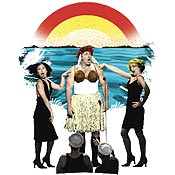
South Pacific may be the one Rodgers and Hammerstein megahit that is really difficult, if not impossible, to revisit today, and I don’t wonder that there hasn’t been a Broadway revival since that first triumphant production in 1949. The recent concert performance in Carnegie Hall once again proved that the score is one of Rodgers’s most spectacular efforts, and even a less-than-ideal cast demonstrated exactly why the show’s songs became standards years ago. But Hammerstein’s book, co-written with Joshua Logan—and perhaps even the literary source, James Michener’s Tales of the South Pacific—is hard to take seriously now, especially after all the racial traumas we’ve been through in the past 50 years. What was once praised as a daring exploration of racial intolerance now seems unbearably condescending and self-righteous, not to mention dramatically unconvincing, and South Pacific comes across as dated as those quaint but musically rich shows Hammerstein wrote back in the twenties, when his composer collaborators included Friml, Youmans, Kern, and Romberg (Show Boat, a true timeless masterpiece, excepted).
In South Pacific, the parallel love stories that unfold on an island paradise during World War II depict nurse Nellie Forbush’s struggle to accept Emile de Becque’s mixed-blood children from an earlier marriage, and Lieutenant Joe Cable’s similar problems with race in his romance with Liat, the innocent Tonkinese daughter of the irrepressible Bloody Mary. One affair ends happily, the other in tragedy, but neither one gets under our skin mainly because the characters remain half-sketched and superficial, even when Rodgers gives them some of his most ear-grabbing songs.
To make matters worse and more artificial, the cast of the Carnegie Hall concert performance, minimally staged by Walter Bobbie and filmed for PBS, hadn’t yet learned the roles. Each singer was glued to a loose-leaf notebook in one hand, and their eyes almost never strayed from the pages. Only one moment threatened to come to theatrical life, when Reba McEntire as Nellie tossed aside her book, donned a sailor suit, and belted out “Honey Bun” with a hand mike. This, in fact, was the country diva’s best moment, since the song responds to her country-and-Western twang better than most of Nellie’s music. It’s an odd coincidence that both McEntire and Mary Martin (the first Nellie) came to South Pacific after wildly successful runs in Annie Get Your Gun. But Nellie’s songs are in a completely different style than Annie’s, and Rodgers and Hammerstein carefully tailored them for Martin, by then a very sophisticated musical-comedy performer (it’s said that R&H intended “A Cockeyed Optimist” to be an actual portrait of her). In comparison, McEntire as Nellie seemed harshly monotonous, ill-prepared, and otherwise completely out of her element.
The rest of the cast at least made capital from the music: Brian Stokes Mitchell as a sonorous Emile, Lillias White as a bouncy and brash Bloody Mary, and Jason Danieley as a lyrical Lieutenant Cable. Alec Baldwin failed to provide much comic relief as Luther Billis—even his drag outfit with its coconut-shell brassiere didn’t seem very funny. No credit was given for the orchestration, but I could recognize a few echoes of Robert Russell Bennett’s original masterly work in the bloated and blatty rendition of the score by the Orchestra of St. Luke’s under Paul Gemignani’s direction.
Rodgers & Hammerstein’s South Pacific
Isaac Stern Auditorium,
Carnegie Hall. June 9.